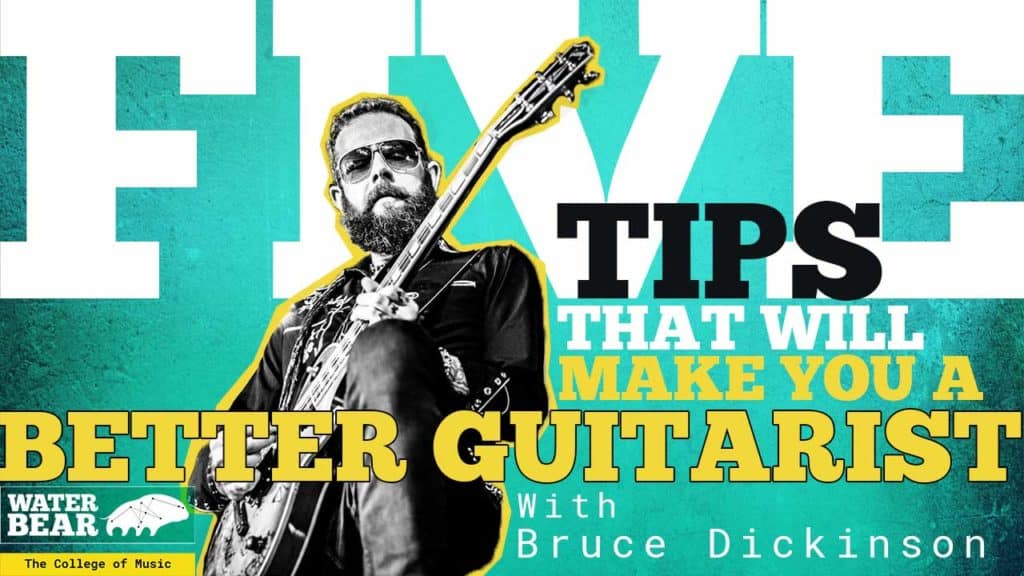JOIN US SEPTEMBER 2024 - APPLY TODAY OR BOOK YOUR PLACE ON ONE OF OUR OPEN DAYS IN BRIGHTON OR SHEFFIELD. UCAS CLEARING IS NOW OPEN.
JOIN US SEPTEMBER 2024 - APPLY TODAY OR BOOK YOUR PLACE ON ONE OF OUR OPEN DAYS IN BRIGHTON OR SHEFFIELD. UCAS CLEARING IS NOW OPEN.

We all want to be better, right? But what exactly does ‘better’ mean for you as a guitar player? The answer depends on your priorities. This blog will help you narrow your focus so you can effectively work towards being the best possible version of yourself.
Younger players are very often preoccupied with technique, speed and flash and there’s definitely a place for that in my heart. I love to hear someone take a room apart with some fierce chops. However, our bodies and nervous systems are all different. In the same way that no matter how hard I trained I could never beat Usain Bolt in a sprint, I could also never have the accuracy and speed on guitar that say Guthrie Govan has. My body isn’t made that way and my nervous system won’t transmit messages or process musical information at the speed Guthrie can, no matter how many hours of practice I put in.
But that’s okay, because this isn’t a competition and, as guitar players, we are all selling our personality as much as anything else. We all have the same notes at our disposal and largely the same harmonic choices, what makes a lick or a song or a part, is the way we make it our own. There’s an awful lot of guitar players out there, but there’s always room for players with a sense of themselves and something to say on the instrument.
I’m going to divide these tips in to two sections: tips 1 and 2 are about improving your craft and honing your skill and 3-5 are centred around refining your own personal style. I’m talking about ‘musical branding’ if you like. Finding your direction on guitar is a very personal journey, everyone has their own path to tread, and by doing so you’ll learn many wider lessons along the way. Understanding guitar is a way to understand life.
So here we go...
Ever wondered why an experienced pro player can play something super simple and yet the performance has gravitas and transmits unshakable confidence? I liken this to a comedian telling a joke. It’s all in the timing. And specifically, the level of control the performer has over that.
If you spend 3 months sorting out your timing, then you won’t believe how many compliments you’ll get from people. An average person in a crowd might not be able to describe how you’ve just pulled a lick back behind the beat, or sat right on a groove, but rest assured they will absolutely understand that ‘here is a serious musician’.
Play with musicians who are better than you
Don’t edit so much when recording - try for complete usable takes
Spend the majority of your practice time with a click, or drum loops, and devise routines that really test your skills such as dropping the click out for 1, 2 or even 4 bars and see if you can stay in time.
Pay attention to rhythm guitar (all guitar is rhythm guitar!) Nothing downgrades a shredder and makes them sound like a bedroom player more than them getting excited and getting ahead of the beat in an uncontrolled way. Listen to the control top players have even when ripping it up. Listen to the groove masters like Rob Harris or Steve Cropper to understand what ‘simple done well’ sounds like.
Test yourself: Play a slow shuffle at 60 bpm and see if you can sit on the click without rushing - not easy!
There’s basically two sort of guitar sounds, and I’m not talking class A/B or analogue/digital. I am talking about a) real tones with sonic integrity - the sort you hear on great recordings and the sort of sound that will still work next to a live kit and through a big PA - and b) poor approximations of the real thing. Whichever direction you go in devising your own signature tone, try and tune up your ears so you don’t get a nasty shock first time you go into the studio with an experienced producer and engineer.
Collect reference tones from great recordings and performances, and really listen hard to what is going on. Try to separate what is coming out of the cab and what elements of the final tone are post speaker eg. room ambience. Research what the ‘raw’ recorded tone was, if you can, as this trips up so many players who think that the sound they hear through the PA or hi-fi speaker is the guitar sound from the cab. The original source tone is often much dryer, has more midrange, has a harmonic richness and has the sonic integrity to hang in there right through it being mix and mastered (and being compressed to bits on some radio station!).
Practice with a bare tone, no reverb or delay and minimal compression and gain. This will do wonders for your tone and you’ll figure out how to get the most tonal response from your guitar. No pedal can save a weak right or left hand, and you can’t boost frequencies that aren’t there. That’s why great amps and pickups often sound awful in the hands of someone inexperienced. They just give you a more detailed sonic picture of what you are putting into it.
Test yourself: Try playing bone dry with a simple lead, no pedals, into something unforgiving like a Hiwatt Custom 50m, a plexi, an AC30, fender twin or a digital version of those amps. This will feel terrible at first as every detail is so ‘in your face’ but stick with this and you’ll discover a whole world of tone in your fingers which will build your confidence. When you revert back to your normal setup, you’ll be amazed at the difference. And so will everyone else.
Guitar, as we know it, came from the blues tradition and often in early blues recordings the lead guitar would take over from the vocal, in a similar register. This worked initially on slide and later on standard electric bends and vibrato could mimic vocal delivery. This is a big plus for the instrument. We can make it sing.
But on top of that, it’s noticeable how many stand out players are also singers. There are the obvious examples with Jimi Hendrix, Peter Green and B.B. King, but also check out the more primitive but effective guitar work of Marc Bolan, Jeff Lynne (ELO etc.) and Neil Young or the lo-fi garage-style work of Kurt Cobain. One thing they all have in common is they have a singer’s approach to note choice and an effective use of space and rhythmic patterns.
Copy people speaking and replicate their conversations on guitar using bends, whammy bar etc. Also concentrate on the rhythmic aspects of speech and the nuances of pitch and dynamic in the questions, answers and statements of everyday conversations.
Apply that learning into a solo but limit your note choice. Try entire solos on the root note for example. Notice how singers often bounce around on two or three notes, whereas a guitarist might feel the need to move round the neck more.
Look at your picking hand and copy the dynamics of a few great singers. Amy Winehouse could go from a roar to a whisper and maybe you can too. Go back to a single note and see how many tones you can get from one note by adjusting your pick attack, angle and placement.
Test yourself: Try tremolo picking and change the volume from very quiet to very loud without stopping the flow of the picking. See how consistent and controlled you can be.
When I tour and I’m on a bill with load of other guitar bands, I get to listen to a lot of sets. That’s a lot of guitar. After every festival I make a mental note: Play fewer notes. There’s an awful lot of guitar notes already floating around, before we add to that let’s be clear what the purpose and point is. Play less but make sure what you do play counts.
Try the Jimmy Hendrix/Eddie Kramer/Chapman trick of playing lead around your breathing. Stop playing when you inhale. It’s a simple trick that forces you to leave space and make use of silence. If you have a super grainy tone you might want to use a noise gate to nip the feedback in the bud or, better still, learn to control the vol pot like Eddie Van Halen whose little finger was forever on the vol pot - dialling it back and forth like a set of gears as he played.
Okay, so this is the big one. In a world full of guitar players, what hope do we have of planting our own flag creatively and doing more than just playing good guitar? Here are some ways you might approach this (but remember, it can take a few years to know what you want so take your time and enjoy the journey):
Listen back to recordings of your own playing and look for small motifs, signatures and techniques that you like. Pick a few of your favourites and try and develop them further. For example, if you have a heavy right hand and favour down strokes, then ask yourself if you could make more of that - could that right hand be even heavier? If you have a big vibrato, could it be even bigger? That sort of line of thought might help you find some exciting lines of stylistic development. The goal is to be ‘more you’.
Identify your three or four main influences and think about why you are drawn to their music. You can take inspiration from aspects of their approach without directly lifting licks. For me, I’ve tried to take a little bit of composition and hot plexi tone from Randy Rhoads, the blues base from Hendrix, a smidge of early Van Halen’s spontaneity and elements of the economy and detail from Peter Green. To that I add in my own personality, my drive for simplicity, and I try to turn limitations into positives. What you don’t do defines you as much as what you do do.
So that’s the Bruce guitar recipe. But more importantly, what’s the ingredients in your guitar… cake? Guitar pie? I think I’ve taken this analogy as far as I can so I think I’ll stop there and go play some guitar!
Take it easy.
Bruce, 2021
To find out more, check out our courses here.

- ‘Water bear’ is the common name for a Tardigrade.
- Tardigrades are micro creatures, found everywhere on earth.
- They are the most resilient creatures known.
- They can survive and adapt to their surroundings, even in outer space.
- Their resilience and ability to adapt and survive inspires us in everything we do. We love them.


WaterBear Education Ltd, Hanover House,
118 Queens Road, Brighton BN1 3XG, UK Map
Email: [email protected]
Tel: +44 (0) 1273 726230
WaterBear Sheffield, Unit 4, Gatecrasher,
49 Eyre Lane, Sheffield S1 4RB, UK
Email: [email protected]
Tel: +44 (0) 1143 992720

WaterBear Education Ltd, Hanover House,
118 Queens Road, Brighton BN1 3XG, UK Map
Email: [email protected]
Tel: +44 (0) 1273 726230
WaterBear Sheffield, Unit 4, Gatecrasher,
49 Eyre Lane, Sheffield S1 4RB, UK
Email: [email protected]
Tel: +44 (0) 1143 992720
- ‘Water bear’ is the common name for a Tardigrade.
- Tardigrades are micro creatures, found everywhere on earth.
- They are the most resilient creatures known.
- They can survive and adapt to their surroundings, even in outer space.
- Their resilience and ability to adapt and survive inspires us in everything we do. We love them.
